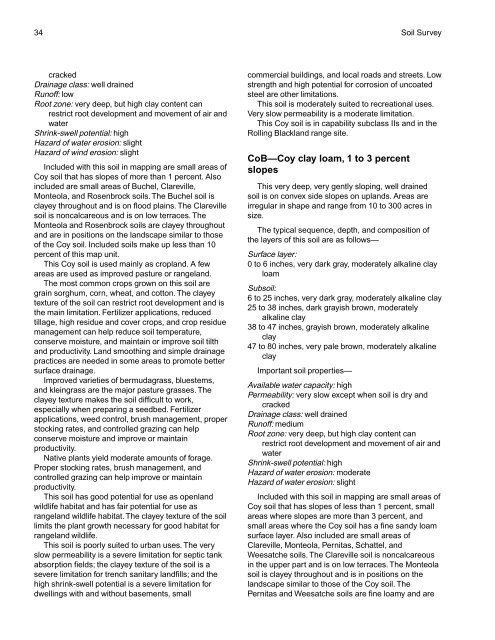Soil Survey of Karnes County, Texas - Soil Data Mart - US ...
Soil Survey of Karnes County, Texas - Soil Data Mart - US ...
Soil Survey of Karnes County, Texas - Soil Data Mart - US ...
You also want an ePaper? Increase the reach of your titles
YUMPU automatically turns print PDFs into web optimized ePapers that Google loves.
34 <strong>Soil</strong> <strong>Survey</strong><br />
cracked<br />
Drainage class: well drained<br />
Run<strong>of</strong>f: low<br />
Root zone: very deep, but high clay content can<br />
restrict root development and movement <strong>of</strong> air and<br />
water<br />
Shrink-swell potential: high<br />
Hazard <strong>of</strong> water erosion: slight<br />
Hazard <strong>of</strong> wind erosion: slight<br />
Included with this soil in mapping are small areas <strong>of</strong><br />
Coy soil that has slopes <strong>of</strong> more than 1 percent. Also<br />
included are small areas <strong>of</strong> Buchel, Clareville,<br />
Monteola, and Rosenbrock soils. The Buchel soil is<br />
clayey throughout and is on flood plains. The Clareville<br />
soil is noncalcareous and is on low terraces. The<br />
Monteola and Rosenbrock soils are clayey throughout<br />
and are in positions on the landscape similar to those<br />
<strong>of</strong> the Coy soil. Included soils make up less than 10<br />
percent <strong>of</strong> this map unit.<br />
This Coy soil is used mainly as cropland. A few<br />
areas are used as improved pasture or rangeland.<br />
The most common crops grown on this soil are<br />
grain sorghum, corn, wheat, and cotton. The clayey<br />
texture <strong>of</strong> the soil can restrict root development and is<br />
the main limitation. Fertilizer applications, reduced<br />
tillage, high residue and cover crops, and crop residue<br />
management can help reduce soil temperature,<br />
conserve moisture, and maintain or improve soil tilth<br />
and productivity. Land smoothing and simple drainage<br />
practices are needed in some areas to promote better<br />
surface drainage.<br />
Improved varieties <strong>of</strong> bermudagrass, bluestems,<br />
and kleingrass are the major pasture grasses. The<br />
clayey texture makes the soil difficult to work,<br />
especially when preparing a seedbed. Fertilizer<br />
applications, weed control, brush management, proper<br />
stocking rates, and controlled grazing can help<br />
conserve moisture and improve or maintain<br />
productivity.<br />
Native plants yield moderate amounts <strong>of</strong> forage.<br />
Proper stocking rates, brush management, and<br />
controlled grazing can help improve or maintain<br />
productivity.<br />
This soil has good potential for use as openland<br />
wildlife habitat and has fair potential for use as<br />
rangeland wildlife habitat. The clayey texture <strong>of</strong> the soil<br />
limits the plant growth necessary for good habitat for<br />
rangeland wildlife.<br />
This soil is poorly suited to urban uses. The very<br />
slow permeability is a severe limitation for septic tank<br />
absorption fields; the clayey texture <strong>of</strong> the soil is a<br />
severe limitation for trench sanitary landfills; and the<br />
high shrink-swell potential is a severe limitation for<br />
dwellings with and without basements, small<br />
commercial buildings, and local roads and streets. Low<br />
strength and high potential for corrosion <strong>of</strong> uncoated<br />
steel are other limitations.<br />
This soil is moderately suited to recreational uses.<br />
Very slow permeability is a moderate limitation.<br />
This Coy soil is in capability subclass IIs and in the<br />
Rolling Blackland range site.<br />
CoB—Coy clay loam, 1 to 3 percent<br />
slopes<br />
This very deep, very gently sloping, well drained<br />
soil is on convex side slopes on uplands. Areas are<br />
irregular in shape and range from 10 to 300 acres in<br />
size.<br />
The typical sequence, depth, and composition <strong>of</strong><br />
the layers <strong>of</strong> this soil are as follows—<br />
Surface layer:<br />
0 to 6 inches, very dark gray, moderately alkaline clay<br />
loam<br />
Subsoil:<br />
6 to 25 inches, very dark gray, moderately alkaline clay<br />
25 to 38 inches, dark grayish brown, moderately<br />
alkaline clay<br />
38 to 47 inches, grayish brown, moderately alkaline<br />
clay<br />
47 to 80 inches, very pale brown, moderately alkaline<br />
clay<br />
Important soil properties—<br />
Available water capacity: high<br />
Permeability: very slow except when soil is dry and<br />
cracked<br />
Drainage class: well drained<br />
Run<strong>of</strong>f: medium<br />
Root zone: very deep, but high clay content can<br />
restrict root development and movement <strong>of</strong> air and<br />
water<br />
Shrink-swell potential: high<br />
Hazard <strong>of</strong> water erosion: moderate<br />
Hazard <strong>of</strong> water erosion: slight<br />
Included with this soil in mapping are small areas <strong>of</strong><br />
Coy soil that has slopes <strong>of</strong> less than 1 percent, small<br />
areas where slopes are more than 3 percent, and<br />
small areas where the Coy soil has a fine sandy loam<br />
surface layer. Also included are small areas <strong>of</strong><br />
Clareville, Monteola, Pernitas, Schattel, and<br />
Weesatche soils. The Clareville soil is noncalcareous<br />
in the upper part and is on low terraces. The Monteola<br />
soil is clayey throughout and is in positions on the<br />
landscape similar to those <strong>of</strong> the Coy soil. The<br />
Pernitas and Weesatche soils are fine loamy and are
















